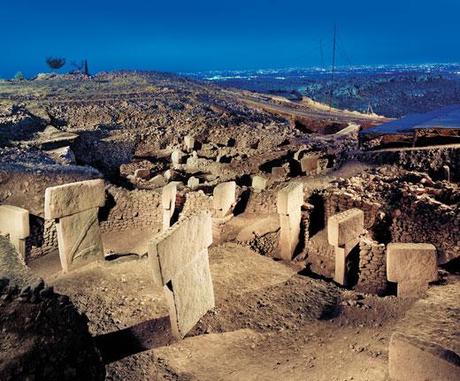The 11,000 year old archaeological site of Göbekli Tepe in southern Turkey is undoubtedly one of the most important in the world. German archaeologist Klaus Schmidt began the ongoing excavations at Göbekli in 1994. Besides being a huge undertaking (less than 5% of the site has been uncovered), the finds — and claims associated with them — have been extraordinary. In a nutshell, these claims are:
- Göbekli was built and used by nomadic hunter-gatherers rather than sedentary agriculturalists.
- It was a religious or ritual pilgrimage center that attracted people from far and wide.
- The massive stone structures or megaliths were “temples” or world’s earliest “churches.”
- It shows that complex organized religion preceded the domestication of plants and animals or Neolithic Revolution.
Why are these extraordinary claims? Because hunter-gatherers aren’t supposed to be doing these things and the order is wrong.

Before Göbekli, the consensus was that the domestication of the plants-animals was a condition precedent to the construction of megaliths and organized worship. After Göbekli, the causal arrows were supposedly reversed. If correct, this is heady stuff: it would mean that ideas and symbols led to or caused the single most important change in the history of humanity. There is no “civilization” without agriculture or food production.
Under the Göbekli scenario proposed by Schmidt and others, religion is not mere superstructure: it is base.
Extraordinary claims require extraordinary evidence, which Göbekli supposedly provides. But does it? In the October 2011 issue of Current Anthropology, University of Toronto archaeologist Edward Banning challenges the Göbekli claims. Banning’s article raises important questions about what has been found and how it has been interpreted.
Because the Göbekli claims and counterclaims are foundational, I will be covering them in a series of posts. In the first, we will look at the site itself and the extensive (sometimes sensational) press coverage, including interviews with Klaus Schmidt. In the second, we will examine Schmidt’s professional publications and site reports for Göbekli. In the third, we will look at the questions raised by Banning in “So Fair a House: Göbekli Tepe and the Identification of Temples in the Pre-Pottery Neolithic of the Near East.” Finally, we will assess the whole to determine whether the extraordinary Göbekli claims are supported by sufficient evidence.
Although Göbekli surely is not (as Spiegel suggested in a 2006 cover story) the lost Garden of Eden, its archaeological and historical importance is undeniable. By the end of the series, we should have a better fix on Göbekli and the claims surrounding it. Is Göbekli an archaeological or metaphorical Stairway to Heaven? I kid but watch the video anyway.
Reference:
Banning, E.B. (2011). So Fair a House: Göbekli Tepe and the Identification of Temples in the Pre-Pottery Neolithic of the Near East Current Anthropology, 52 (5), 619-660 DOI: 10.1086/661207



